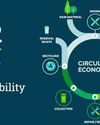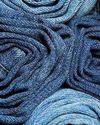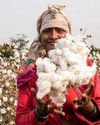Business

Textile Value Chain
EPR in Textiles: Turning Compliance into Opportunity
When the EU Comes to Panipat, It Means One Thing — The World Is Watching
3 min |
November 2025

Textile Value Chain
European Parliament Delegation Visits Panipat Recycling Cluster to Strengthen India-EU Collaboration on Circular Textiles
A high-level delegation from the European Parliament's Committee on International Trade (INTA) visited the Panipat Textile Recycling Cluster — India's largest hub for recycled textiles and circular manufacturing — during their official visit to India.
1 min |
November 2025

Textile Value Chain
Paramount Instruments: Where Innovation Turns Testing into Joy
At Paramount Instruments, innovation isn't just a Pursuit- it's in our DNA.
2 min |
November 2025
Textile Value Chain
Crafting the Future: LMW & Hami Weavelon pioneer Compact Spinning in Polyester
Manmade fibres today form the backbone of the global textile industry, driven by their versatility, performance, and ability to meet the rising demand for both everyday and specialised applications.
3 min |
November 2025

Textile Value Chain
Data is the New Thread: Weaving India's Textile Sector into a Circular Powerhouse
On November 13, 2025, at the 12th Edition of the India and Sustainability Standards (ISS) International Dialogue and Conference held at Bharat Mandapam in New Delhi, representatives from the Home Exporters Welfare Association of India (HEWA) joined industry leaders, policymakers, and international organizations to address a pressing question: How can India's textile sector meet emerging global data requirements while supporting its MSME backbone?
3 min |
November 2025

Textile Value Chain
Rieter Winding Suction Nozzle Upgrade: More Yarn, Less Energy Use
After upgrading the suction nozzles on their 32 winding machines, Sanyang Textile Co., Ltd., China, saw an increase in yarn production of 3% and a reduction of 13% in energy use. The flow-optimised, aerodynamically designed suction nozzle enables efficient upper yarn search and pickup from the package. This results in a 55% reduction in red light percentage and a significant reduction in the operator's workload.
1 min |
November 2025

Textile Value Chain
EU's Extended Producer Responsibility (EPR) Law and Its Implications for India's Textile Industry
The European Union (EU) has approved a new Extended Producer Responsibility (EPR) framework for textiles. This is a major regulatory shift that makes fashion brands and producers accountable for their products' entire lifecycle, from design and production through collection, sorting, recycling and disposal.
9 min |
November 2025

Textile Value Chain
GTE Ahmedabad 2025 Concludes Day 3 with a Huge Footfall
The 38th Garment Technology Expo (GTE) Ahmedabad 2025, co-located with the Lace & Trims Show, wrapped up its third day on an impressive note, recording around 9,700 B2B visitors. The strong industry turnout reaffirmed the expo's role as one of the most influential and business-driven platforms for garment and apparel technology in the western region.
2 min |
November 2025

Textile Value Chain
Reinterpreting Korean Street Fashion through Sustainable Design Practices
A Path through Eco-conscious Urban Fashion
7 min |
November 2025

Textile Value Chain
3D Printing in Textiles Manufacturing: A Game-Changer in Design, Sustainability, and Efficiency
The global textile and apparel industry is undergoing a radical transformation due to the convergence of digital design, advanced material technology, and next-generation manufacturing. Of the latter, few have greater potential to change how textiles are made today than additive manufacturing, better known as 3D printing.
5 min |
November 2025

Textile Value Chain
ITMA ASIA + CITME 2025: Singapore Edition Draws International Acclaim
The region's premier textile and garment technology showcase, ITMA ASIA + CITME, made a highly successful return to Singapore, marking its first comeback since the 2001 and 2005 editions. Held from October 27 to 31, 2025, at the Singapore Expo, the four-day event was celebrated for its impressive international reach and robust buyer turnout from across Asia and beyond.
2 min |
November 2025
Textile Value Chain
From Plant to Pants: The Complete Journey of Hemp Denim Workwear Production
When you think of workwear that can take a beating, denim comes to mind. For decades, cotton denim has been the gold standard for industrial clothing. But there’s a more sustainable alternative making waves in the textile world: hemp denim. This isn’t just about being eco-friendly for the sake of it. Hemp denim is genuinely tough, breathable, and could be the answer to some of the fashion industry's biggest environmental challenges.
5 min |
November 2025
Textile Value Chain
Future Outlook & Conclusion: The Next Phase of Textile Manufacturing
7 min |
November 2025

Textile Value Chain
3D Printing in Textile Production: Weaving the Future, Layer by Layer
What if someone told you that the future of fashion might not rely on scissors, sewing machines, or piles of fabric scraps?
5 min |
November 2025

Textile Value Chain
The Impact of Textile Automation: Transforming an Industry Thread by Thread
Walk into any modern textile factory today, and you'll witness something remarkable.
7 min |
October 2025

Textile Value Chain
Textile Circularity - A Decade of Experiments and Experiences at Meemansa
The textile industry is a paradox: it is a generator of beauty, culture, and livelihoods - yet also one of the most resource-intensive and waste-producing sectors in the world.
6 min |
October 2025

Textile Value Chain
Geopolitical Risks and the Future of Indian Textile Exports: Navigating an Uncertain World
The global textile trade, once anchored in predictable economic cycles and established trade corridors, now finds itself navigating one of the most volatile geopolitical landscapes in decades. From the Russia x Ukraine war to the conflict in West Asia, from U.S. x China, U.S. x India tariff hostilities to fragmented global trade alliances, uncertainty has become the new constant.
4 min |
October 2025
Textile Value Chain
Australia's Cotton Industry in 2025: Navigating Markets, Sustainability, and Change
As the Australian cotton season draws to a close in October 2025, the industry stands at a pivotal moment shaped by steady production, dynamic export trends, and a sharpened focus on sustainability.
3 min |
October 2025

Textile Value Chain
It's the Machine Era...Upgrade to Safeguard & Magnify Textiles!!!
Our world is surrounded by automated systems; we wake up to the chirping sounds of alarms, and with another touch, the coffee maker starts brewing.
7 min |
October 2025

Textile Value Chain
MATEXIL Chairman's Address: Navigating Global Challenges with Vision and Resilience
At the 71st Annual General Meeting of MATEXIL, Chairman Shaleen Toshniwal delivered a comprehensive address that reflected both the turbulence of the past year and the promising opportunities ahead for India's man-made fibre (MMF) and technical textiles sectors.
5 min |
October 2025

Textile Value Chain
Textile Automation Impact
We explore how automation is redefining the textile and apparel industries — not just in technology, but in the very foundation of production, sustainability, and competitiveness.
4 min |
October 2025

Textile Value Chain
NIT Jalandhar Signs MoU with Tynor Orthotics, Mohali
The Department of Textile Technology at Dr B. R. Ambedkar National Institute of Technology (NIT), Jalandhar, has signed a Memorandum of Understanding (MoU) with Tynor Orthotics Pvt. Ltd., a leading Indian manufacturer of orthopaedic and healthcare products.
1 min |
October 2025

Textile Value Chain
Recycled Polyester Fabric: From Plastic Bottles to Your Wardrobe
Every day, millions of plastic bottles end up in trash bins around the world.
5 min |
October 2025

Textile Value Chain
TMMA's 65th Annual General Meeting: Charting the Future of India's Textile Machinery Sector
The Textile Machinery Manufacturers' Association (India) successfully organised its 65th Annual General Meeting (AGM), Export and R&D Awards Function, and a high-level stakeholder consultation at the India ITME Centre, Mumbai. The event brought together industry leaders, policymakers, and innovators to reflect on the current state of the textile machinery sector and chart the path forward.
6 min |
October 2025

Textile Value Chain
India Gets its First: Liva Reviva™ M Marks a New Milestone in Recycled Cellulosic Fibre
Redefining fashion's environmental future, Birla Cellulose has introduced Liva Reviva™ M: India's first next-generation circular fibre.
1 min |
October 2025

Textile Value Chain
Restitching Confidence in India's Textile Industry: Duty Waiver Impact
India’s textile sector has received a timely policy nudge.
4 min |
October 2025

Textile Value Chain
Your Next Big Buyer Won't Ask for Price - They'll Ask for Your Scope 3
Introduction: Every Step Has a Footprint
3 min |
October 2025

Textile Value Chain
TMMA's 65th Annual General Meeting: Charting the Future of India's Textile Machinery Sector
The Textile Machinery Manufacturers' Association (India) successfully organised its 65th Annual General Meeting (AGM), Export and R&D Awards Function, and a high-level stakeholder consultation at the India ITME Centre, Mumbai. The event brought together industry leaders, policymakers, and innovators to reflect on the current state of the textile machinery sector and chart the path forward.
6 min |
October 2025

Textile Value Chain
Textile Circularity - A Decade of Experiments and Experiences at Meemansa
The textile industry is a paradox: it is a generator of beauty, culture, and livelihoods - yet also one of the most resource-intensive and waste-producing sectors in the world.
6 min |
October 2025

Textile Value Chain
Your Next Big Buyer Won't Ask for Price - They'll Ask for Your Scope 3
Every time we make a piece of clothing — from buying cotton to spinning yarn, weaving fabric, stitching garments, transporting, and even the way the customer washes it — we leave behind a footprint.
3 min |
